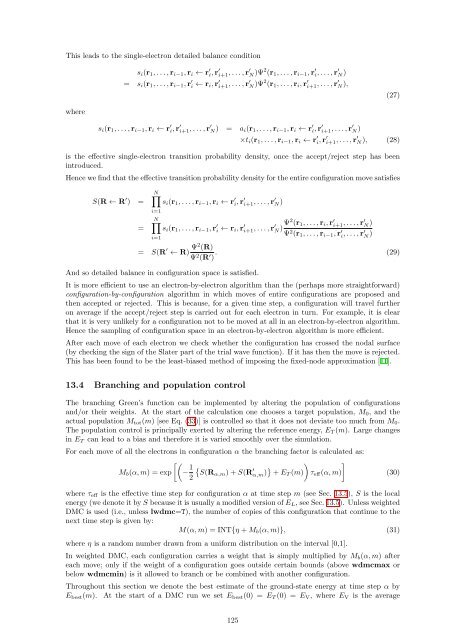CASINO manual - Theory of Condensed Matter
CASINO manual - Theory of Condensed Matter
CASINO manual - Theory of Condensed Matter
You also want an ePaper? Increase the reach of your titles
YUMPU automatically turns print PDFs into web optimized ePapers that Google loves.
This leads to the single-electron detailed balance condition<br />
s i (r 1 , . . . , r i−1 , r i ← r ′ i, r ′ i+1, . . . , r ′ N)Ψ 2 (r 1 , . . . , r i−1 , r ′ i, . . . , r ′ N )<br />
= s i (r 1 , . . . , r i−1 , r ′ i ← r i , r ′ i+1, . . . , r ′ N)Ψ 2 (r 1 , . . . , r i , r ′ i+1, . . . , r ′ N),<br />
(27)<br />
where<br />
s i (r 1 , . . . , r i−1 , r i ← r ′ i, r ′ i+1, . . . , r ′ N) = a i (r 1 , . . . , r i−1 , r i ← r ′ i, r ′ i+1, . . . , r ′ N)<br />
×t i (r 1 , . . . , r i−1 , r i ← r ′ i, r ′ i+1, . . . , r ′ N ), (28)<br />
is the effective single-electron transition probability density, once the accept/reject step has been<br />
introduced.<br />
Hence we find that the effective transition probability density for the entire configuration move satisfies<br />
S(R ← R ′ ) =<br />
=<br />
N∏<br />
s i (r 1 , . . . , r i−1 , r i ← r ′ i, r ′ i+1, . . . , r ′ N)<br />
i=1<br />
N∏<br />
i=1<br />
s i (r 1 , . . . , r i−1 , r ′ i ← r i , r ′ i+1, . . . , r ′ N) Ψ2 (r 1 , . . . , r i , r ′ i+1 , . . . , r′ N )<br />
Ψ 2 (r 1 , . . . , r i−1 , r ′ i , . . . , r′ N )<br />
= S(R ′ ← R) Ψ2 (R)<br />
Ψ 2 (R ′ ) . (29)<br />
And so detailed balance in configuration space is satisfied.<br />
It is more efficient to use an electron-by-electron algorithm than the (perhaps more straightforward)<br />
configuration-by-configuration algorithm in which moves <strong>of</strong> entire configurations are proposed and<br />
then accepted or rejected. This is because, for a given time step, a configuration will travel further<br />
on average if the accept/reject step is carried out for each electron in turn. For example, it is clear<br />
that it is very unlikely for a configuration not to be moved at all in an electron-by-electron algorithm.<br />
Hence the sampling <strong>of</strong> configuration space in an electron-by-electron algorithm is more efficient.<br />
After each move <strong>of</strong> each electron we check whether the configuration has crossed the nodal surface<br />
(by checking the sign <strong>of</strong> the Slater part <strong>of</strong> the trial wave function). If it has then the move is rejected.<br />
This has been found to be the least-biased method <strong>of</strong> imposing the fixed-node approximation [11].<br />
13.4 Branching and population control<br />
The branching Green’s function can be implemented by altering the population <strong>of</strong> configurations<br />
and/or their weights. At the start <strong>of</strong> the calculation one chooses a target population, M 0 , and the<br />
actual population M tot (m) [see Eq. (33)] is controlled so that it does not deviate too much from M 0 .<br />
The population control is principally exerted by altering the reference energy, E T (m). Large changes<br />
in E T can lead to a bias and therefore it is varied smoothly over the simulation.<br />
For each move <strong>of</strong> all the electrons in configuration α the branching factor is calculated as:<br />
[(<br />
M b (α, m) = exp − 1 {<br />
S(Rα,m ) + S(R ′<br />
2<br />
α,m) } ) ]<br />
+ E T (m) τ eff (α, m)<br />
where τ eff is the effective time step for configuration α at time step m (see Sec. 13.5), S is the local<br />
energy (we denote it by S because it is usually a modified version <strong>of</strong> E L , see Sec. 13.5). Unless weighted<br />
DMC is used (i.e., unless lwdmc=T), the number <strong>of</strong> copies <strong>of</strong> this configuration that continue to the<br />
next time step is given by:<br />
M(α, m) = INT{η + M b (α, m)}, (31)<br />
where η is a random number drawn from a uniform distribution on the interval [0,1].<br />
In weighted DMC, each configuration carries a weight that is simply multiplied by M b (α, m) after<br />
each move; only if the weight <strong>of</strong> a configuration goes outside certain bounds (above wdmcmax or<br />
below wdmcmin) is it allowed to branch or be combined with another configuration.<br />
Throughout this section we denote the best estimate <strong>of</strong> the ground-state energy at time step α by<br />
E best (m). At the start <strong>of</strong> a DMC run we set E best (0) = E T (0) = E V , where E V is the average<br />
(30)<br />
125

















